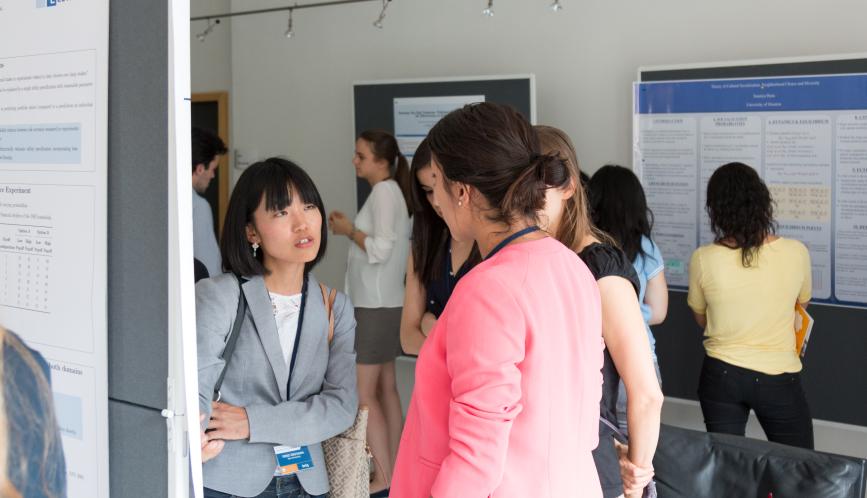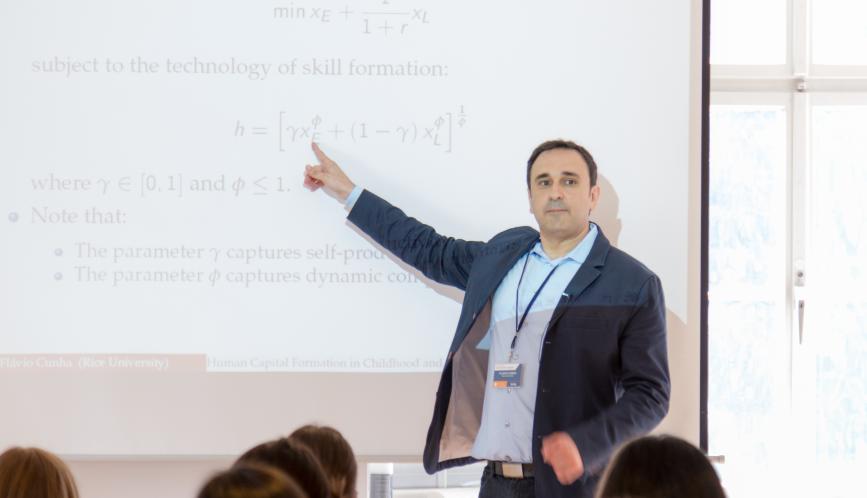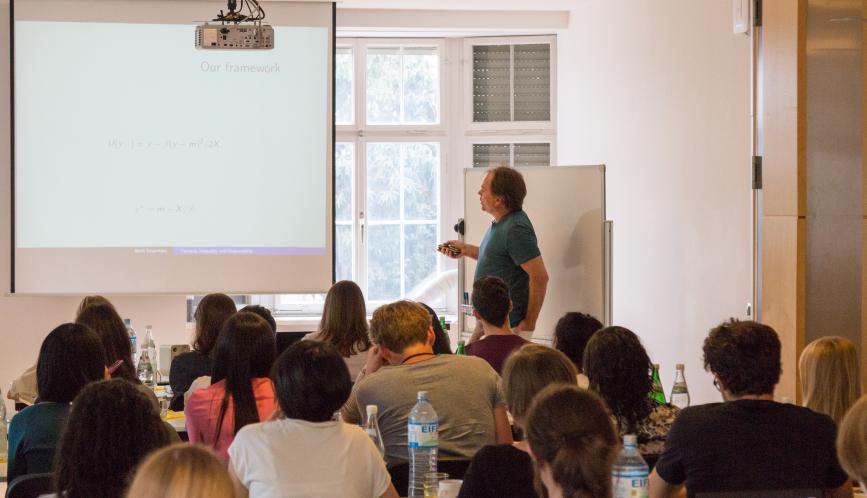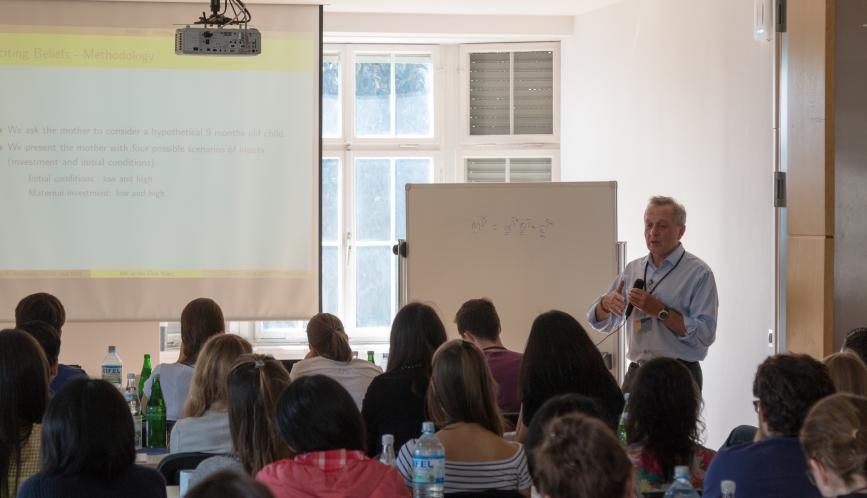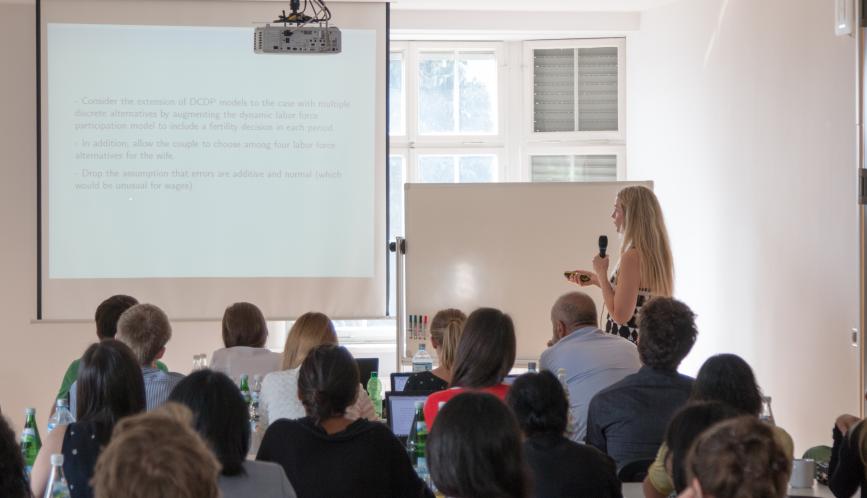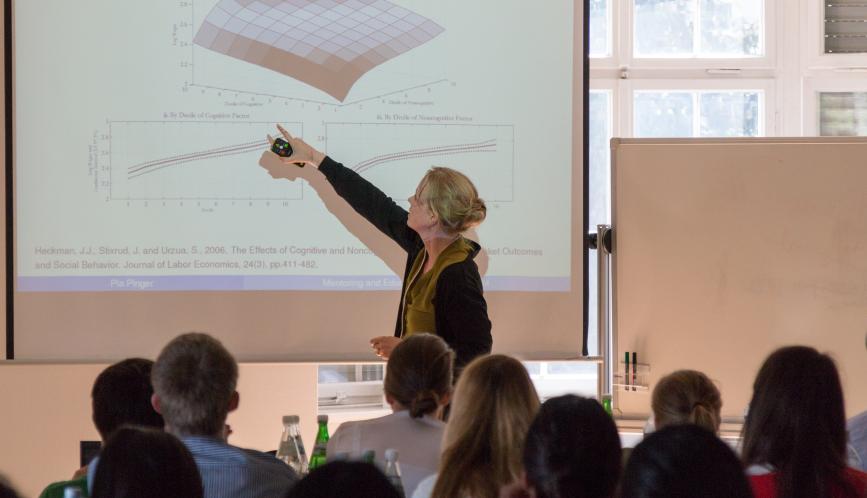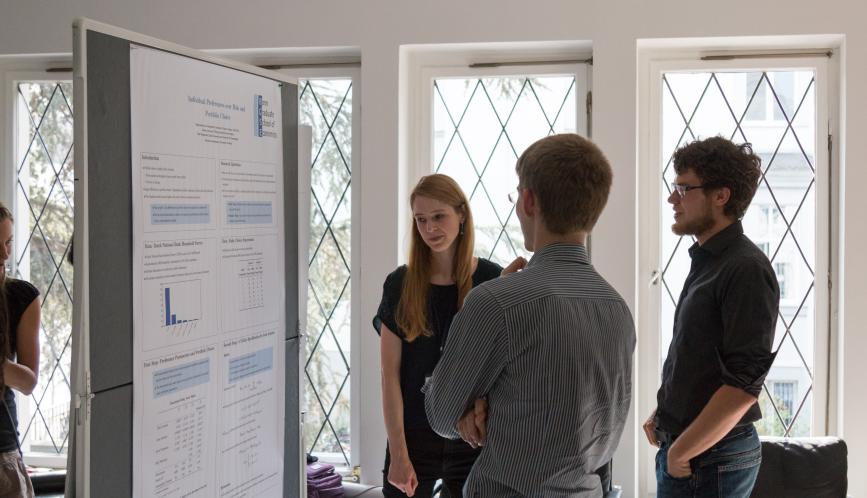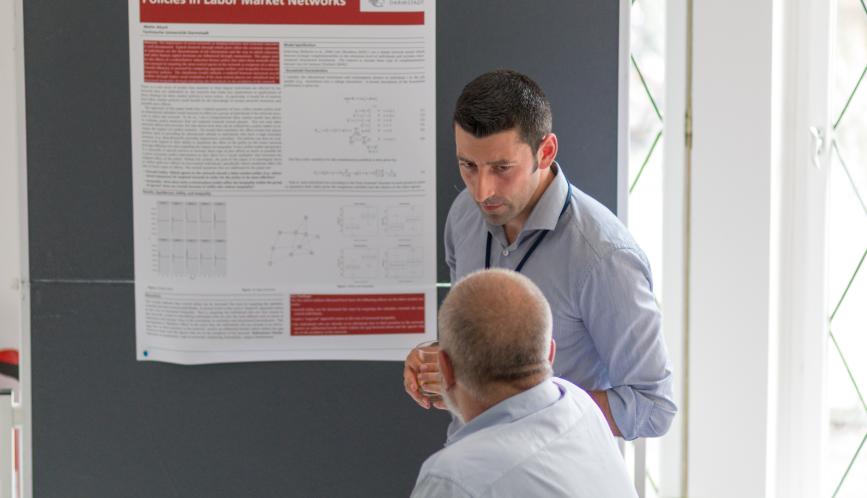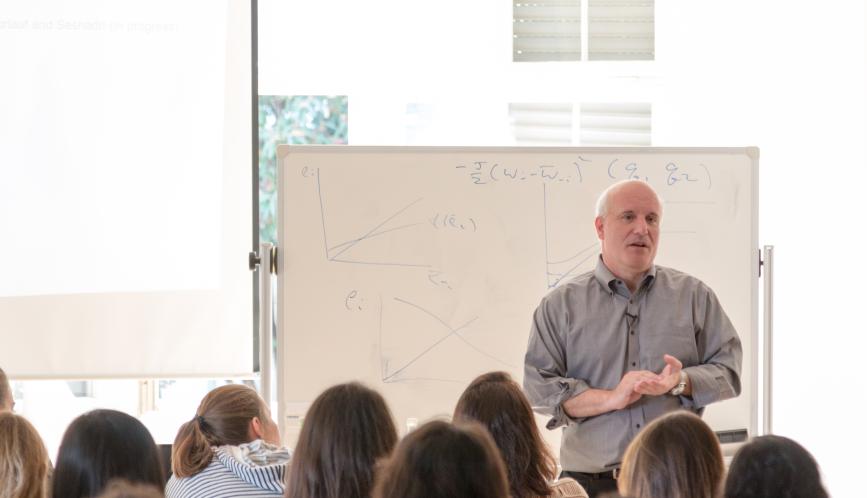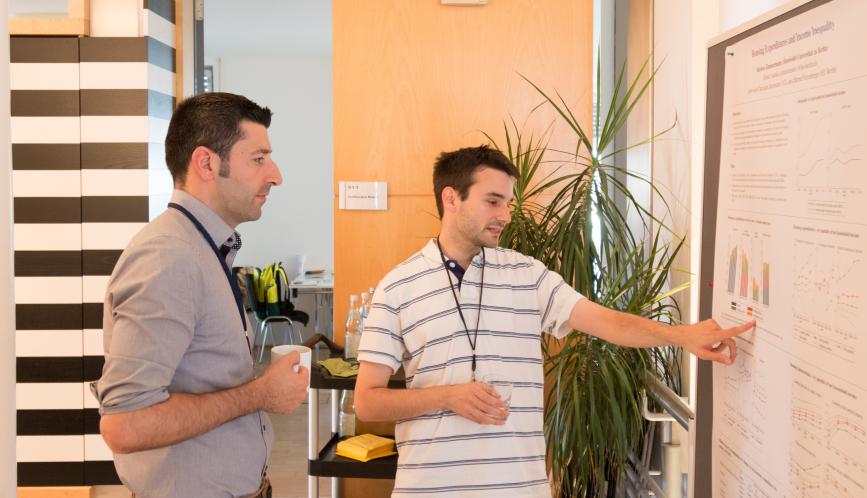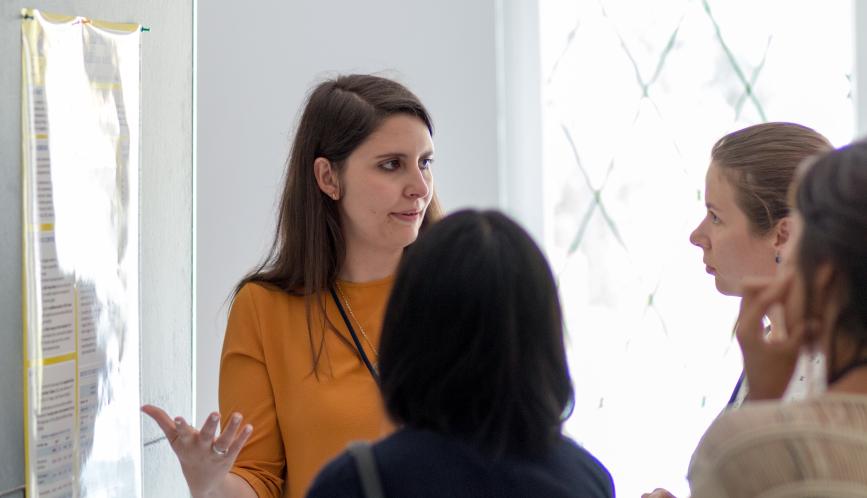The 2016 Human Capital and Economic Opportunity Global Working Group Summer Schools on Socioeconomic Inequality will provide a state-of-the-art overview on the study of inequality and human flourishing. Participants will learn about the integration between psychological and sociological insights into the foundations of human behavior and conventional economic models. Through rigorous lectures students will be trained on various tools needed to study the issue of inequality. The summer school is open to Ph.D. and early postdoctoral scholars from around the world. There is no fee to attend SSSI Bonn. Students will be provided lodging for the week as well as breakfast and lunch daily. Students are expected to cover travel costs to and from the Summer School and any additional expenses they may incur.
Tactical Links
Search

Tactical Links
Program
August 29, 2016
Lunch Break
Human Capital Formation in Childhood and Adolescence--Reading List
Theory of Human Capital Formation:
- Becker, Gary and Nigel Tomes (1986). “Human Capital and the Rise and Fall of Families,” Journal of Labor Economics, Vol. 4(3): S1-39.
- Cunha, Flavio and James J. Heckman (2007). “The Technology of Skill Formation,” American Economic Review, Vol. 97(2): 31-47.
Early Human Capital Accumulation
- Heckman, James; Rodrigo Pinto, and Maria Rosales (2014). "Estimating the Treatment Effects of the Nurse Family Partnership Up to Age 12." Unpublished manuscript, University of Chicago, Center for the Economics of Human Development.
- Conti, Gabriela; Jorge Garcia; James Heckman; Andres Hojman; Seong Hyeok Moon; Ji Min Park; Rodrigo Pinto; Jake Torcasso. (2014). "The Treatment Effects of the Abecedarian Project." Unpublished manuscript, University of Chicago, Center for the Economics of Human Development.
- Heckman, James; Azeem Shaik; and Rodrigo Pinto. (2014). "Correcting for Uncertainty in the Randomization Protocol of the Perry Preschool Project." Unpublished manuscript, University of Chicago, Center for the Economics of Human Development.
- Attanasio, O., Murtaza, S. and Veras-Hernandez, M. (2004). “Early Evaluation of a New Nutrition and Education Programme in Colombia,” Institute for Fiscal Studies Briefing Note No. 44.
- Macours, Karen, Norbert Schady, and Renos Vakis. (2012). “Cash transfers, behavioral changes, and cognitive development in early childhood: Evidence from a randomized experiment,” American Economic Journal: Applied Economics 4 (2), 247-273.
Human Capital Formation in Elementary and Secondary Education
Class Size and Peers:
- Lazear, Edward (2001). “Educational Production,” Quarterly Journal of Economics, Vol. 116(3): 777-803.
- Krueger, Alan (1999). “Experimental Estimates of Education Production Functions,” Quarterly Journal of Economics, Vol. 114(2): 497-532.
- Araujo, Maria Caridad; Carneiro, Pedro; Cruz-Aguayo, Yyannu; Schady, Norbert (2014). “A Helping Hand? Teacher Quality and Learning Outcomes in Kindergarten,” University College London Working Paper.
- Glewwe, P., Ilias, N. and Kremer, M. (2003). "Teacher Incentives." NBER Working Paper Series No. 9671.
- Duflo, E., Hanna, R. and Ryan, S. (2007). “Monitoring Works: Getting Teachers to Come to School,” American Economic Review, Vol. 102(4): 1241-1278.
School Choice: Vouchers and Charter Schools
- Mayer, Daniel, Paul Peterson, David Myers, Christina Clark Tuttle and William Howell (2002). “School Choice in New York City After Three Years: An Evaluation of the School Choice Scholarships Program,” Mathematica Policy Research Report.
- Peterson, P. (2003). “School Vouchers: Results from Randomized Experiments,” in C. Hoxby, ed. The Economics of School Choice, Chicago: University of Chicago Press.
- Dobbie, Will and Roland G. Fryer. (2010) “Are High-Quality Schools Enough to Increase Achievement Among the Poor? Evidence from the Harlem Children’s Zone,” NBER Working Paper No. 15473.
- Kane, Thomas J. and Douglas O. Staiger (2002). “The Promises and Pitfalls of Using Imprecise School Accountability Measures,” Journal of Economic Perspectives, Vol. 16(4): 91-114.
Human Capital Formation in Higher Education
Market for Higher Education:
- Rothschild, M. and White, L. J. (1995). “The Analytics of the Pricing of Higher Education and Other Services in Which the Customers Are Inputs,” Journal of Political Economy, Vol. 103(3): 573-586.
- Hoekstra, M. (2009). “The Effect of Attending the Flagship State University on Earnings: A Discontinuity-Based Approach,” Review of Economics and Statistics, Vol. 91(4): 717-724.
- Avery, Christopher & Hoxby, Caroline. (2013) “The Missing ‘One-Offs’: The Hidden Supply of High-Achieving, Low Income Students.” Brookings Papers on Economic Activity, Spring.
- Hoxby, Caroline & Turner, Sarah (2015). “Expanding College Opportunities for High-Achieving, Low-Income Students.” Stanford Institute for Economic Policy Research Discussion Paper 12-014.
- Bettinger, Eric P., Bridget Terry Long, Philip Oreopoulos, Lisa Sanbonmatsu (2009). “The Role of Simplification and Information in College Decisions: Results from the H&R Block FAFSA Experiment.” National Bureau of Economic Research Working Paper No. 15361.
- Azoulay, Pierre; Zivin, Joshua S. Graff; and Wang, Jialan (2010): “Superstar Extinction,” Quarterly Journal of Economics, Vol. 125 (2): 549-589
Human Capital Formation in the Labor Market
- Ricardo Cossa, James J. Heckman, and Lance J. Lochner (2003). “Learning-By-Doing Vs. On-the-Job Training: Using Variation Induced by the EITC to Distinguish Between Models of Skill Formation,” in Phelps. E. (ed.) Designing Inclusion: Tools to Raise Low-end Pay and Employment in Private Enterprise, Cambridge: Cambridge University Press.
Education as a Signal
- Bedard, Kelly J. (2001) “Human Capital versus Signaling Models: University Access and High School Dropouts,” Quarterly Journal of Economics, Vol. 109(4): 749-775.
- Weiss, Andrew. 1995. “Human Capital vs. Signaling Explanations for Wages,” Journal of Economic Perspectives, Vol. 9(4): 133—154.
Fairness, Inequality, and Responsibility--Reading List
Presentation Slides
Reading List
- Almås, Ingvild, Alexander W. Cappelen, and Bertil Tungodden. (2016). "Cutthroat capitalism versus cuddly socialism: Are Americans more meritocratic or efficiency-seeking than Scandinavians?" Unpublished manuscript, Norwegian School of Economics.
- Cappelen, Alexander W. , Sebastian Fest, Erik Ø. Sørensen, and Bertil Tungodden. (2016). "Choice and personal responsibility: What is a morally relevant choice?" Unpublished manuscript, Norwegian School of Economics.
- Cappelen, Alexander W., Ranveig Falch, and Bertil Tungodden. (2016). "The boys crisis: Do we find it more acceptable to hold males responsible than females?" Unpublished manuscript, Norwegian School of Economics.
- Cappelen, Alexander W., Tom Eichele, Kenneth Hugdahl, Karsten Specht, Erik Ø. Sørensen, and Bergil Tungodden. (2014). "Equity theory and fair inequality: A neuroeconomic study." Proceedings of the National Academy of Science,111(43): 15369-15372.
- Cappelen, Alexander W., James Konow, Erik Ø. Sørensen, and Bertil Tungodden. (2013). "Just luck: An experimental study of risk taking and fairness." American Economic Review, 103(4): 1398-1413.
- Cappelen, Alexander W., Karl Ove Moene, Erik Ø. Sørensen, and Bertil Tungodden. (2013). "Needs vs entitlements - an international fairness experiment." Journal of European Economic Association, 11(3): 574-598.
- Almås, Ingvild, Alexander W. Cappelen, Jo Thori Lind, Erik Ø. Sørensen, and Bertil Tungodden. (2011). "Measuring unfair (in)equality." Journal of Public Economics, 95(7-8): 488-499.
- Almås, Ingvild, Alexander W. Cappelen, Erik Ø. Sørensen, and Bertil Tungodden. (2010). "Fairness and the development of inequality acceptance." Science, 328 (5982): 1176-1178.
- Cappelen, Alexander W., Erik Ø. Sørensen, and Bertil Tungodden. (2010). "Responsibility for what? Fairness and individual responsibility." European Economic Review, 54(3): 429-441.
- Cappelen, Alexander W., Astri D. Hole, Erik Ø. Sørensen, and Bertil Tungodden. (2007). "The pluralism of fairness ideals: An experimental approach." American Economic Review, 97(3): 818-827.
August 30, 2016
Preference Heterogeneity: Global Evidence, Determinants and Consequences I
Parental Investments, Public Policies and Human Capital Accumulation during the Early Years in Developing Countries and Beyond
Lunch Break
Parental Investments, Public Policies and Human Capital Accumulation During the Early Years in Developing Countries and Beyond--Reading List
Introduction
-
The process of Human Capital Accumulation in the Early Years: What We Know and What We Don't.
- The production function of human capital
- Issues specific to developing countries
-
Parental investments:
- Objectives
- Resources
- Beliefs
-
Public policies and interventions
- Challenges in developing countries
- Evidence on specific interventions
- Scalability
Readings
My lecture will take freely from my presidential address to the European Economic Association that covers much of the material. The students may find the references in that paper useful. I will also use additional material.
- * Attanasio O.P. (2015) “The Determinants of Human Capital Formation During the Early Years of Life: Theory, Measurement and Policies”, Journal of the European Economic Association, 13(6): 949–997.
The production function of human capital
- * Cunha, F., J. Heckman, L. Lochner, and D. Masterov (2006). "Interpreting the evidence on life cycle skill formation." In E. Hanushek, S. Machin, and L. Woessmann (Eds.), Handbook of the Economics of Education, Volume 1. Elsevier Science.
- * Cunha, F., J. Heckman, and S. Schennach (2010). "Estimating the technology of cognitive and non-cognitive skill formation." Econometrica, 78 , 883 – 931.
- Almond, D. and J. Currie (2011). "Human capital development before age five." In O. Ashenfelter and D. Card (Eds.), Handbook of Labor Economics, Volume 4b. Elsevier Science.
- *Attanasio, O., S. Cattan, E. Fitzsimons, C. Meghir, and M. Rubio-Codina (2015). "Estimating the production function for human capital: Results from a randomized control trial in Colombia." NBER Working Paper 20965.
- * Attanasio, O., C. Meghir and E. Nix (2015) "Human Capital Development and Parental Investment in India." NBER WP No 21740.
- Hackman, D., M. Farah, and M. Meaney (2010). "Socioeconomic status and the brain: mechanistic insights from human and animal research." Nature Reviews: Neuroscience, 11(9), 651–59.
- McGregor, S. G., Y. Cheung, S. Cueto, P. Glewwe, L. Richter, and B. Strupp (2007). "Developmental potential in the first 5 years for children in developing countries." The Lancet 369 (9555), 60 – 70.
Policy interventions
- * Engle, P. L., L. C. H. Fernald, H. Alderman, J. Behrman, C. O'Gara, A. Yousafzai, M. C. de Mello, M. Hidrobo, N. Ulkuer, I. Ertem, S. Iltus, and the Global Child Development Steering Group (2011). "Strategies for reducing inequalities and improving developmental outcomes for young children in low-income and middle-income countries." Lancet 378, 1339–53.
- * Gertler, P., J. Heckman, R. Pinto, A. Zanolini, C. Vermeerch, S. Walker, S. Chang, and S. Grantham-McGregor (2014). "Labor market returns to an early childhood stimulation intervention in Jamaica." Science, 344(6187): 998-1001.
- * Grantham-McGregor, S., C. Powell, S. Walker, and J. Himes (1991). "Nutritional supplementation, psychosocial stimulation, and mental development of stunted children: the Jamaican study." Lancet, 338(8758): 1-5.
- Heckman, J., R. Pinto, and P. Savelyev (2013). "Understanding the mechanisms through which an influential early childhood program boosted adult outcomes." American Economic Review 103(5), 2052–2086.
- Heckman, J. J., S. H. Moon, R. Pinto, P. A. Savelyev, and A. Yavitz (2009). "The rate of return to the High/Scope Perry Preschool Program." IZA WP No 4533.
- *Attanasio, O., C. Fernandez, E. Fitzsimons, S. Grantham-McGregor, C. Meghir, and M. Rubio-Codina (2014). "Using the infrastructure of a conditional cash transfer programme to deliver a scalable integrated early child development programme in Colombia: a cluster randomised controlled trial." British Medical Journal. 349, g5785.
- Campbell, F., G. Conti, J. Heckman, S. Moon, R. Pinto, E. Pungello, and Y. Pan (2014). “Early childhood investments substantially boost adult health”. Science 343(6178), 1478–1485.
- Andrew, A., O. Attanasio, E. Fitzsimons, and M. Rubio-Codina (2014). "The (in)effectiveness of multiple micronutrient powder in treating and preventing childhood anaemia in Colombia: analysis, discussion and wider implications of a randomised controlled trial." SSM- Population Health, 2016.
- Fitzsimons, E., B. Malde, A. Mesnard, and M. Vera-Hernandez (2014). "Nutrition, information, and household behavior: Experimental evidence from Malawi." IFS Working Paper No. 14/02.
- Walker, S., S. Chang, C. Powell, and S. Grantham-McGregor (2005). "Effects of early childhood psychosocial stimulation and nutritional supplementation on cognition and education in growth-retarded jamaican children: a prospective cohort study." The Lancet 366(9499), 1804–07.
Parental investment
- Almond, D. and B. Mazumder (2013). "Fetal origins and parental responses." The Annual Review of Economics 5(3), 1–20.
- Hart, B. and T. Risley (1995). Meaningful Differences in the Everyday Experience of Young American Children. Brookes Publishing.
- Lareau, A. (2003). Unequal Childhoods: Class, Race, and Family Life. University of California Press. Berkeley and Los Angeles.
- *Attanasio, O., S. Cattan, E. Fitzsimons, C. Meghir, and M. Rubio-Codina (2015). "Estimating the production function for human capital: Results from a randomized control trial in Colombia." NBER Working Paper 20965.
- * Attanasio, O., C. Meghir and E. Nix (2015) "Human Capital Development and Parental Investment in India." NBER WP No 21740
- Cunha, F., I. Elo, and J. Culhane (2013). "Eliciting maternal beliefs about the technology of skill formation." NBER Working Paper No 19144.
Intrahousehold allocations
- Becker, G. and N. Tomes (1976). "Child endowments and the quantity and quality of children." Journal of Political Economy 84(4), S143–S162.
- Behrman, H. and A. Deolalikar (1990). "Intrahousehold demand for nutrients in rural south India: individual estimates, fixed effects and permanent income." Journal of Human Resources 25(4), 665–696.
- Behrman, J. (1988). "Intrahousehold allocation of nutrients in rural India: Are boys favored? Do parents exhibit inequality aversion?" Oxford Economic Papers 40, 324.
- Griliches, Z. (1979). "Sibling models and data in economics: Beginnings of a survey." Journal of Political Economy 87(5), S37–64.
- Yi, J., J. Heckman, J. Zhang, and G. Conti (2016). “Early health shocks, intrahousehold resource allocation, and child outcomes”. Economic Journal, 125(588): F347-F371.
- Hanushek, E. and L. Woessmann (2008). "The role of cognitive skills in economic development." Journal of Economic Literature, 46(3), 607-668.
September 1, 2016
Using Contextual Variation To Identify Critical Periods In Child Development
Poster Session I
Lunch Break
Coffee Break
August 31, 2016
Coffee Break
Lunch Break
Cultural Inequality--Reading List
Abstract
Cultural explanations of socio-economic phenomena are often considered tautological or, at best, residual explanations. This does not have to be the case as long as theoretical and empirical restrictions are imposed on what is culture, how cultural traits are distributed across the population, and how they evolve over time. The present course surveys a vast literature on the evolution of culture which imposes theoretical and empirical restrictions on what is culture, how cultural traits are distributed across the population, and how they evolve over time. The objective is to provide a general account and some elements for the explanation of the observed cultural inequality across the population, for different classes of cultural traits, transmitted by means of different mechanisms, e.g. at different time frequencies.
Introduction
We generally define culture to represent those components of preferences, attitudes, and beliefs which depend upon the capacity for social learning and transmission across generations.
This definition allows us to frame the object of our study formally in terms of the properties of preference orderings of agents (as typically represented by utility functions) as well as of probability distributions over the properties of the environment they face. At the same time, the definition highlights the fundamental transmission mechanisms behind the evolution of culture, social learning and inter-generational transmission.
Consequently, the present course will attempt at providing a categorization of cultural traits and of transmission mechanisms as well as, most importantly, a map between them. First of all, cultural traits are typically not independent objects, they come and are transmitted in bundles. This is e.g., evidently the case for ethnic traits. Furthermore, different classes of traits are trans- mitted by means of different mechanisms, e.g. at different time frequencies. Some general form of risk aversion or time-discounting might be the result of natural selection, while political attitudes, religious preferences, ethnic identity are certainly transmitted via faster social learning mechanisms like, e.g., inter-generational transmission and/or peer effects. Depending on the different time frequencies, cultural traits are or are not significantly modified in their form and composition as they evolve. Some cultural traits are affected as agents interact with the environment, which might change fast relatively to evolutionary time. This is the case, generally, for ethnic and religious traits. In many interesting cases, cultural evolutionary processes are indeed fast enough that the distribution of the population with respect to a set of cultural trait represents the only dynamics of interest, while traits themselves are approximately given. Finally, in many instances the same traits are subject to different mechanisms governing their evolution at different time frequency. While e.g., some general form of time-discounting might be an evolutionary adaptation, its effect on behavior is generally mediated through parental socialization e.g., to self-control.
The survey will be structured as follows. We shall first of all briefly touch upon the evidence for cultural inequality across the population, for different classes of cultural traits. We will then study more in detail the classes of theoretical models of the evolution of cultural traits which can account for the observed cultural diversity, again for different classes of cultural traits transmitted by means of different mechanisms, e.g. at different time frequencies. More specifically, we first concentrate on cultural traits which are considered evolutionary adaptations, the result of evolutionary selection or of gene-culture evolution. We then concentrate on ethnic traits, introducing phylogenetic models theoretically and reviewing their application to the ethnic traits with genetic, linguistic, and archaeological data. Finally, we concentrate on the population dynamics of the distribution of cultural traits, distinguishing and comparing different specific elements of the transmission mechanisms studied in the literature.
Evidence of Cultural Diversity - Selected References
-
Alesina, A., A. Devleeschauwer, W. Easterly, S. Kurlat, and R. Wacziarg (2003). Fractionalization. Journal of Economic Growth, 8 (June). 155-194.
Alesina, A. and P. Giuliano (2015). "Culture and Institutions," Section 2.3, Journal of Economic Literature, 53(4). 898-944. - Becker, T. Dohmen, B. Enke, A. Falk, D. Huffman, U. Sunde (2016). "The Preference Survey Module: A Validated Instrument for Measuring Risk, Time, and Social Preferences," mimeo, University of Bonn.
- A. Becker, T. Dohmen, B. Enke, A. Falk, D. Huffman, U. Sunde (2016). "The Nature and Predictive Power of Preferences: Global Evidence," IZA DP No. 9504.
- Cheung, F. M., F.J.R. van de Vijver, and F.T.L. Leong (2011). "Toward a new approach to the study of personality in culture". American Psychologist , 66, 593-603.
- Desmet, K., I. Ortuno-Ortin, and R. Wacziarg (2016). "Culture, ethnicity, and diversity," mimeo, UCLA.
- Dohmen, T., A. Falk, D. Huffman, and U. Sunde (2006). "The Intergenerational Transmission of Risk and Trust Attitudes," IZA Discussion Paper 2380.
- T. Dohmen, B. Enke, A. Falk, D. Huffman, U. Sunde (2015). "Patience and The Wealth of Nations," mimeo, University of Bonn.
-
R. Fisman, P. Jakiela, and S. Kariv (2016). "Distributional Preferences and Political Behavior," mimeo, UC Berkeley.
Fractionalization Data - The Macro Data Guide: http : //www.nsd.uib.no/macrodataguide/set.html?id= 16&sub = 1 - Y. Gorodnichenko and G. Roland (2011). "Individualism, innovation, and long-run growth," Proceedings of the National Academy of the Sciences, 108, suppl. 4.
- Heckman, J. and S. Mosso (2014). "The economics of human development and social mobility," Annual Reviews, Vol. 6: 689-733.
- Hofstede, G. (2001). "Cultures Consequences: Comparing Values, Behavior, and Organizations across Nations," New York, Sage Publications.
- Henrich, J., R. Boyd, S. Bowles, C. Camerer, E. Fehr, and H. Gintis (2004). Foundations of Human Sociality: Economic Experiments and Ethnographic Evidence from Fifteen Small- Scale Societies, Oxford, Oxford University Press.
- Jang, K., W. J. Livesley, and P.A. Vemon (1996). "Heritability of the Big Five Personality Dimensions and Their Facets: A Twin Study," Journal of Personality, 64 (3), 577-591.
- Lewis, M.P., ed., (2009). Ethnologue: Languages of the World, SIL International, New York, 16th Edition.
- Spolaore, E. and R. Wacziarg (2016). "Ancestry, Language and Culture," in Victor Ginsburgh and Shlomo Weber (eds.), The Palgrave Handbook of Economics and Language, Chapter 6, pp. 174-211, London: Palgrave Macmillan, 2016.
- World Value Survey Database: http://www.worldvaluessurvey.org/wvs.jsp
Adaptations: Gene-culture coevolution - Selected References
- Barkow, J.H., L. Cosmides, and J. Tooby (1992). The Adapted Mind: Evolutionary Psychology and the Generation of Culture, New York, Oxford University Press.
- Bisin, A. and T. Verdier (2001b). "Agents with imperfect empathy may survive natural selection," Economics Letters, 71, 277-85.
- Bergstrom, T. (1995). "On the Evolution of Altruistic Ethical Rules for Siblings," American Economic Review, 85, 58-81.
- Bouchard, T.J., M. McGue (2003). "Genetic and environmental influences on human psycho- logical differences," Journal of Neurobiology 54 (1), 445.
- Boyd, Robert, and Peter Richerson (1985). Culture and the Evolutionary Process, Chicago, IL, University of Chicago Press.
- Boyd, R. and P.J. Richerson (1989). "The evolution of indirect reciprocity," Social Networks, 11, 213-36.
- Bowles, S. and H. Gintis (2003). "Origins of Human Cooperation," in P. Hammerstein, ed., Genetic and Cultural Evolution of Cooperation, Cambridge, MA, MIT Press.
- Bowles, S. and H. Gintis (2013). A Cooperative Species: Human Reciprocity and Its Evolution, Princeton, Princeton University Press.
- Durham, W.H. (1991). Coevolution: Genes, Culture, and Human Diversity, Stanford, Stanford University Press.
- Durham, W.H. (1992). "Applications of evolutionary culture theory," Annual Review of Anthropology, 21, 331-55.
- Feldman, M.W. and K.N. Laland (1996). "Gene-culture Coevolution Theory," Trends in Ecology & Evolution, 11(11), 453-7.
- Gintis, H. (2003a). "Solving the Puzzle of Prosociality," Rationality and Society, 15, 155–87.
- Gintis, H. (2003b). "The Hitchhikers Guide to Altruism: Genes, Culture and the Internalization of Norms," Journal of Theoretical Biology, 220, 407–18.
- McCrae R. R., A. Terracciano, and 79 Members of the Personality Profiles of Cultures Project (2005). "Personality profiles of cultures: Aggregate personality traits, Journal of Person- ality and Social Psychology, 89(3), 407-425.
- Otto S.P, Christiansen, F. B., and Feldman, M. W. (1994). "Genetic and Cultural Inheritance of Continuous Traits," Morrison Institute for Population and Resource Studies, Working Paper 0064, Stanford University.
- Robson, A. and L. Samuelson (2010). "The evolutionary foundation of preferences," in J. Ben- habib, A. Bisin and M.O. Jackson (eds.), Handbook of Social Economics, Amsterdam, El- sevier Publisher, vol. I, ch. 7.
- Rogers A.R., and E. Cashdan (1997). "The Phylogenetic Approach to Comparing Human Pop- ulations," Evolution of Human Behavior, 18, 353–358.
Ethnic Traits: Change and splitting - Selected References
- Becker, B. Enke, A. Falk (2015). "The Ancient Origins of Cross-Country Heterogeneity in Risk Preferences," mimeo, University of Bonn.
- Boyd, R. and P.J. Richerson (2005). The Origin and Evolution of Cultures, Oxford, Oxford University Press.
- Cavalli Sforza, L.L., P. Menozzi, and A. Piazza (1994). The History and Geography of Human Genes, Princeton, NJ, Princeton University Press.
- Felsenstein, J. (2004). Inferring Phylogenies, Sunderland, Ma, Sinauer Associates Publishers.
- Foerster, P. and C. Renfrew, eds., (2006). Phylogenetic Methods and the Prehistory of Languages, Cambridge, McDonald Institute for Archeological Research, Cambridge University Press.
- Garamszegi, L.Z. (ed. 2014). Modern Phylogenetic Comparative Methods and Their Application in Evolutionary Biology: Concepts and Practice, Berlin, Springer.
- Mace, R., C.J. Holden, and S. Shennan, eds., (2005). The Evolution of Cultural Diversity: A Phylogenetic Approach, Walnut Creek, Ca, Left Coast Press.
- Peregrine, P.N., I. Peiros, and M. Feldman (2009). Ancient Human Migrations: A Multidisciplinary Approach, Salt Lake City, UT, University of Utah Press.
- Rendine, S., A. Piazza, and L.L. Cavalli Sforza (1986). "Simulation and Separation by Principal Components of Multiple Demic Expansions in Europe," The American Naturalist, 128(5), 681-706.
Population dynamics - Selected References
- Akerlof, G.A. and R.E. Kranton (2000). "Economics and Identity," Quarterly Journal of Economics, 115, 715-753.
- Ammerman, A.J. and L.L. Cavalli Sforza (1984). The Neolithic Transition and the Genetics of Populations in Europe, Princeton, Princeton University Press.
- Becker G.S. (1996). Accounting for Taste, Cambridge, MA, Harvard University Press.
- Bisin, A. and T. Verdier (2010). "The Economics of Cultural Transmission and Socialization, in Handbook of Social Economics, Jess Benhabib, Alberto Bisin, Matt Jackson, eds., Elsevier, 2010.
- Bisin, A., Topa, G. and Verdier, T. (2004a). "Religious Intermarriage and Socialization in the United States," Journal of Political Economy, 112, 615–64.
- Bisin, A and Verdier, T. (2000). "Beyond the Melting Pot: Cultural Transmission, Marriage and the Evolution of Ethnic and Religious Traits," Quarterly Journal of Economics, 115, 955–88.
- Bisin, A and Verdier, T. (2001a). "The Economics of Cultural Transmission and the Dynamics of Preferences," Journal of Economic Theory, 97, 298–319.
- Cavalli Sforza L.L. and M. Feldman (1981). Cultural Transmission and Evolution: A Quantitative Approach, Princeton, NJ, Princeton University Press.
- Cavalli Sforza, L.L. and M. Feldman (1973). "Cultural Versus Biological Inheritance: Phenotypic Transmission from Parent to Children," American Journal of Human Genetics, 25, 618-37.
Preference Heterogeneity: Global Evidence, Determinants and Consequences II and III
September 2, 2016
Poster Session II
Poster Session III
Lunch Break
Social Determinants of Inequality--Reading List
Note: Please read items in bold first
Lecture 1: Ethics and Inequality
Abstract
This lecture will provide an overview of normative issues which arise in evaluating levels of inequality and disadvantage. Alternative philosophical approaches will be contrasted.
Reading List
- Anderson, E. (1999). "What is the Point of Equality?" Ethics 109: 287-337.
- Anderson, E. (2007). "Fair Opportunity in Education: A Democratic Equality Perspective." Ethics 117: 595-622.
- Arrow, K. (1973). "Some Ordinalist-Utilitarian Notes on Rawl’s Theory of Justice." Journal of Philosophy 70: 245-263.
- Basu, K. and L. Lopez-Calva. (2011). "Capabilities and Functionings." Handbook of Social Choice and Welfare, K. Arrow, A. Sen, and K. Suzumura, eds. Amsterdam: Elsevier.
- Blume, L. and S. Durlauf. (2015). "Capital in the Twenty-First Century: A Review Essay." Journal of Political Economy, forthcoming.
- Buchanan, J. (1971). "Equality as Fact and Norm." Ethics 81: 228-240.
- Diamond, P. (1967). "Cardinal Welfare, Individualistic Ethics and Interpersonal Comparisons of Utility: Comment." Journal of Political Economy 75: 765-766.
- Durlauf, S. (2006). "Assessing Racial Profiling," Economic Journal 116: F402-F426.
- Durlauf, S. (2008). "Affirmative Action, Meritocracy, and Efficiency." Politics, Philosophy, & Economics 7: 131-158.
- Feser, E. (1997). "Hayek on Social Justice: Reply to Lukes and Johnston." Critical Review 11: 581-606. (matched with Lukes and Johnston)
- Fishkin, J. (2014). "The Anti-Bottleneck Principle in Employment Discrimination Law." Washington University Law Review 91: 1429-1518.
- Fleurbaey, M., B. Tungodden and H. Chang. (2003). "Any Non‐Welfarist Method of Policy Assessment Violates the Pareto Principle: A Comment." Journal of Political Economy 111: 1382-1385
- Harsanyi, J. (1955). "Cardinal Welfare, Individualistic Ethics and Interpersonal Comparisons of Utility." Journal of Political Economy 63: 309-321.
- Hausman, D. and M. Waldren. (2011). "Egalitarianism Reconsidered." Journal of Moral Philosophy 8: 567-586.
- Johnston, D. 1997. "Hayek’s Attack on Social Justice." Critical Review 11: 81-100. (matched with Feser and Lukes)
- Kaplow, L. and S. Shavell. (2001). "Any Non-Welfarist Method of Policy Assessment Violates the Pareto Principle." Journal of Political Economy 109: 281-286.
- Konow, J. (2003). "Which Is the Fairest One of All? A Positive Analysis of Justice Theories." Journal of Economic Literature 41: 1188-1239.
- Lukes, S. (1997). "Social Justice: The Hayekian Challenge." Critical Review 11: 65-80. (matched with Feser and Johnston)
- Mason, A. (2001). "Egalitarianism and the Levelling Down Objection." Analysis 61: 246-254.
- Nussbaum, M. (2003). "Capabilities as Fundamental Entitlements: Sen and Social Justice." Feminist Economics 9: 33-59.
- Parfit, D. (1997). "Equality and Priority." Ratio 10: 202-221.
- Roemer J. (1993). "A Pragmatic Theory of Responsibility for the Egalitarian Planner." Philosophy and Public Affairs 22: 146-166.
- Roemer, J. (2001). "Three Egalitarian Views and American Law." Law and Philosophy 20: 433-460.
- Roemer, J. and A. Trannoy. (2015). "Equality of Opportunity." Handbook of Income Distribution. A. Atkinson and F. Bourguignon, eds. Amsterdam: Elsevier.
- Satz, D. (2012). "Unequal Chances: Race, Class and Schooling." Theory and Research in Education 10: 155-170.
- Sen, A. 1979. "Equality of What?" Tanner Lecture on Human Values. http://tannerlectures.utah.edu/lectures/documents/sen80.pdf
- Sen A. 2000. "Social Justice and the Distribution of Income." Handbook of Income Distribution. A. Atkinson and F. Bourguignon, eds. Amsterdam: Elsevier.
- Sher, G. 1979. "Effort, Ability, and Personal Desert." Philosophy & Public Affairs*;361-376.
- Sher, G. 2012. "Talents and Choices." Nous 46: 400-417.
Lecture 2: Interdependences and Inequality
Abstract
This lecture will describe how complementarities and spillover effects constitute mechanisms for the generation of inequality. Interaction effects are shown to both produce correlated behaviors between members of various socioeconomic groups as well as to produce incentives for segregation of individual types into distinct groups.
Reading List
- Becker, G. 1973. "A Theory of Marriage, Part I" Journal of Political Economy, 81, 4, 813-846.
- Bénabou, R. 1996. "Equity and Efficiency in Human Capital Investment: The Local Connection," Review of Economic Studies, 63, 2, 237-264.
- Bisin, A., O. Ozgur, and U. Horst. 2006. "Rational Expectations Equilibria of Economies with Local Interactions," Journal of Economic Theory 127: 74-116.
- Blume, L. 1993. "The Statistical Mechanics of Strategic Interaction." Games and Economic Behavior 5: 387-424.
- Brock, W. and S. Durlauf. 2001. "Discrete Choice with Social Interactions," Review of Economic Studies 68: 235-260.
- Cabrales, A., A. Calvó-Armengol and Y. Zenou. 2011. "Social Interactions and Spillovers." Games and Economic Behavior 72: 339-360.
- Choo, E. and A. Siow. 2006. "Who Marries Whom and Why." Journal of Political Economy 114: 172-201.
- Dupuy, A. and A. Galichon. 2012. "Canonical Correlation and Assortative Matching: A Remark." IZA Discussion Paper no. 6942.
- Durlauf, S. 1996. "A Theory of Persistent Income Inequality." Journal of Economic Growth, 1: 75-93.
- Durlauf, S. 1996. "Neighborhood Feedbacks, Endogenous Stratification and Income Inequality." Dynamic Disequilibrium Modelling, W. Barnett, G. Gandolfo, and C. Hillinger, eds., Cambridge: Cambridge University Press.
- Durlauf, S. 2006. "Groups, Social Influences, and Inequality: A Memberships Theory Perspective on Poverty Traps," in Poverty Traps, S. Bowles, S. Durlauf, and K. Hoff, eds., Princeton: Princeton University Press.
- Durlauf, S. and A. Seshadri. 2003. "Is Assortative Matching Efficient?" Economic Theory 21: 475-493.
- Fernandez, R. and J. Gali. 1999. "To Each According to…? Markets, Tournaments, and the Matching Problem with Borrowing Constraints." Review of Economic Studies 66: 799-824.
- Fernandez, R. and R. Rogerson. 1996. "Income Distribution, Communities, and the Quality of Public Education," Quarterly Journal of Economics 111: 135-164.
- Gall, T., P. Legros, and A. Newman. 2012. "Mismatch, Rematch, and Investment," Working Paper, Boston University.
- Hammersley, J. and P. Clifford. 1971. "Markov Fields on Finite Graphs and Lattices." Mimeo.
- Horst, U. and J. Scheinkman. 2006. "Equilibria in Systems of Social Interactions." Journal of Economic Theory 130: 44-77.
- Kremer, M. and E. Maskin. 1996. "Wage Inequality and Segregation by Skill," NBER Working Paper no. 5718.
- LeGros, P. and A. Newman. 2002. "Monotone Matching in Perfect and Imperfect Worlds," Review of Economic Studies 69: 925-942.
- LeGros, P. and A. Newman. 2007. "Beauty Is a Beast, Frog Is a Prince: Assortative Matching with Nontransferabilities." Econometrica, 75: 1073-1102.
- Lindenlaub, I. 2013. "Sorting Multidimensional Types: Theory and Application." Mimeo.
- McCann, R., X. Shi, A. Siow, and R. Wolthoff. 2012. "Becker Meet Ricardo: Multisector Matching with Cognitive and Noncognitive Skills," Working Paper, University of Toronto.
- Prat, A. 2002. "Should a Team be Homogeneous?" European Economic Review 46: 1187-1207.
- Sattinger, M. 1993. "Assignment Models of the Distribution of Earnings." Journal of Economic Literature 31: 831‑880.
- Shimer, R. and L. Smith. 2000. "Assortative Matching and Search." Econometrica 68: 343-369.
- Spitzer, F. 1971. "Markov Random Fields and Gibbs Ensembles." American Mathematical Monthly 78: 142-154.


